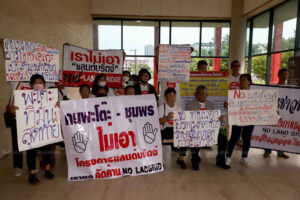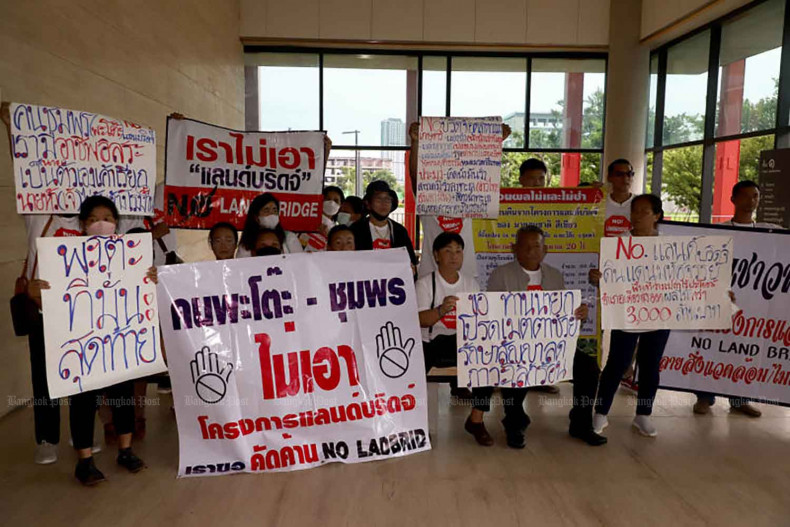
Thailand’s Land Bridge – from Ranong on the Andaman coast to Chumphon on the Gulf of Thailand – falls flat
Shipping sector lukewarm, though property speculators keen
As Thailand’s political future hangs in the balance, so too does one of the country’s most ambitious mega-infrastructure proposals: the Land Bridge Project, envisioned as a transformative logistics corridor linking the Gulf of Thailand with the Andaman Sea.
Proposed as a strategic alternative to the busy Strait of Malacca, the 1.1 trillion baht project seeks to turn Thailand into a regional transhipment and manufacturing hub.
But despite high-level endorsements and preliminary studies, scepticism continues to mount — from shipping industry veterans to grassroots campaigners and policy analysts.
A game-changer?
The project involves building two deep-sea ports — Ranong on the Andaman coast and Chumphon on the Gulf of Thailand — a 90-kilometre dual-track railway and motorway for container transfer, supporting logistics infrastructure including intermodal terminals, and a Special Economic Zone (SEZ).
The first phase, costing around 500 billion baht, is set to start operations in 2030, with full completion by 2039 at a total cost of 1.1 trillion baht.By 2039, investment breakdown includes: Chumphon Port (300 billion baht), Ranong Port (330 billion baht), and the Ship-to-Rail Transfer Operation system (140 billion baht), plus 220 billion baht for connectivity infrastructure.
Initially, Ranong port will handle 6 million containers and Chumphon 4 million annually. By 2039, combined capacity is expected to reach 20 million containers per year.
The government says the Land Bridge will reduce shipping times by up to five days, cut costs, and enhance Thailand’s position as a key logistics competitor in the region.
Political time pressure
Despite its grand scale, the project’s future remains politically fragile. Analysts say that any shake-up in the Pheu Thai Party-led coalition government could derail progress entirely.
Former Bangkok deputy governor Samart Ratchapolsitte, a long-time critic of megaproject economics, warned the project may never move beyond feasibility studies — especially as those studies appear, in his view, to present overly optimistic projections.
“From all indications, the study seems engineered to justify the investment, but if you speak to real players in the maritime industry, the numbers simply don’t add up,” said Mr Samart.
Mr Samart and several unnamed shipping executives say the Land Bridge model introduces more logistical friction, not less.
“I spoke with several ocean shipping companies, and they all shook their heads. They’re not interested in using the Land Bridge because it would only increase costs. It won’t save time or reduce expenses,” he said.
The key criticism centres on the double handling of cargo. Goods would have to be offloaded from vessels on one coast, transported by truck or rail across 90 kilometres, and reloaded onto another ship on the opposite side.
“This process takes time and negates any time savings the Land Bridge might offer over the Strait of Malacca,” the source said. “In fact, it would likely take longer and cost more.”
Container logistics bottleneck
“Container loading and unloading are not simple. Heavy containers must be placed on the bottom, and those for earlier destinations on top. It requires detailed planning, and the larger the vessel — especially those carrying tens of thousands of containers — the more time-consuming the process becomes.”
He recounted a recent observation trip on a cargo vessel from the Bangkok port to Laem Chabang port.
“I saw firsthand just how long it takes to load and unload containers,” he said. “That’s why I find it puzzling the Office of Transport and Traffic Policy and Planning (OTP) concluded the Land Bridge project is cost-effective. Based on practical experience, it appears quite the opposite.”
In the past, international investors have shown interest in the Land Bridge project.
Notably, in 2008, Dubai World, a state-owned company from the United Arab Emirates, signed a memorandum of understanding with OTP. The company agreed to fund a feasibility study for the project, commissioning a Dutch firm to conduct the research. At the time, the estimated cost of the project exceeded 500 billion baht.

The Land Bridge project remains a recurring topic of political campaigns. Despite government claims the project is progressing toward an investment phase, industry insiders continue to question whether the government can deliver on its ambitious promises.
Industry resistance
Insiders in the shipping world remain unconvinced by the project’s logic. A major pain point is the proposed double handling of cargo, as mentioned above.
Ships would offload containers at Ranong (or Chumphon). Containers would then be transferred via truck or train across 90 km. Finally, they would be reloaded onto other vessels on the opposite coast.
“Every additional transfer costs time and money,” one industry source said.
“Container handling is a precise science. It’s not just about moving boxes — it’s about sequencing, safety, and delivery windows.”
Critics argue the extra steps could negate any potential time savings over sailing through the Strait of Malacca, especially when accounting for delays in cross-docking, customs processing, and scheduling connecting vessels.
“Even if the land route saves five days on paper, it could lose more than that in transfer delays,” said one operator, adding shipping giants would rather deal with a known chokepoint than a costly and untested new system.
Moreover, cargo density in the Land Bridge region is low. Without industrial clusters nearby, ships may lack sufficient cargo volume to make stopovers at Ranong or Chumphon worthwhile.
Investors uncertain
According to insiders, the few investors showing interest are foreign real estate developers, not logistics operators. That has raised concerns the project could become another speculative land scheme, rather than the logistics powerhouse it claims to be.
“We’re seeing more interest from those who want to build around the ports, not operate them,” one source said.
This disconnect between infrastructure vision and industry demand could derail the entire investment model, which is based on a single, large-scale public-private partnership with open foreign investment.
The government plans to allow unlimited foreign shareholding in the project, acknowledging that hundreds of billions of baht will be needed upfront. However, no consortium has stepped forward.
Hurdles in the House
Complicating matters further is the proposed Southern Economic Corridor (SEC) bill, required to enable the Land Bridge’s development and operation. The bill remains stalled amid protests and criticism from civil society.

Prasitchai Nunuan, a leading member of the SEC Watch group, spoke out on the latest developments regarding the legislation. The group had previously submitted a protest to Prime Minister Paetongtarn Shinawatra at Government House on March 11.
Mr Prasitchai said the government’s momentum in pushing the SEC project appears to be waning due to its lack of political stability. However, he stressed the group would closely monitor the SEC bill, a necessary legal framework for advancing the project.
Firm govt commitment
Transport Minister Suriya Jungrungreangkit has refuted reports of any halt to the project, calling them false.
He said the project is still in the study and design phase, with a bidding process expected by 2026.
The Office of Transport and Traffic Policy and Planning (OTP) has hired consultants to conduct environmental impact assessments, preliminary designs, and a business development model.

Delays from the Covid-19 pandemic pushed the timeline, but officials now claim progress is back on track with bidding set in two to three years, he said.
Punya Chupanit, OTP director-general, said negotiations are ongoing with potential investors from China and Dubai, specifically port developers and shipping lines.
Bold vision or political bait?
Thailand’s strategic location undeniably positions it well for regional logistics. But critics argue the Land Bridge risks becoming another white elephant — a megaproject long on ambition and short on market demand.
“It resurfaces every election season, then disappears,” one analyst noted. “It’s been used more as political bait than a logistics solution.”
Whether it becomes a genuine engine of economic transformation — or joins the list of Thailand’s unrealised megaprojects — depends not only on political will, but on market realism, the analyst said.
Source: https://www.bangkokpost.com/thailand/special-reports/3068113/thailands-land-bridge-falls-flat



